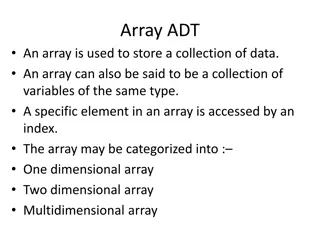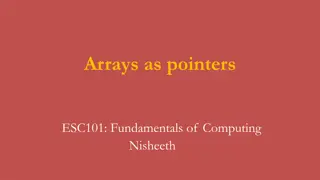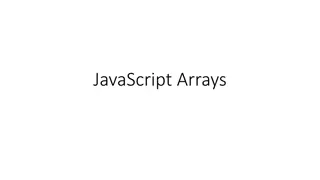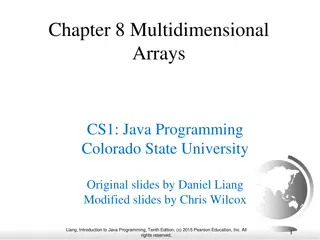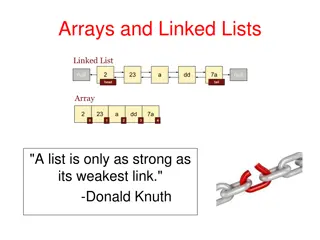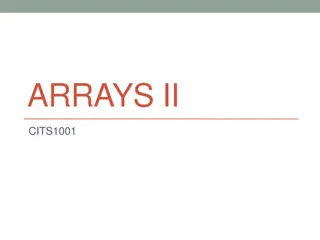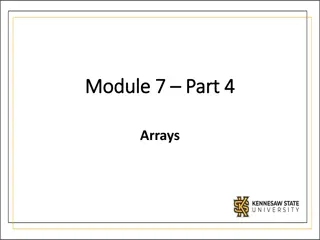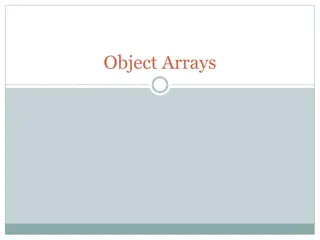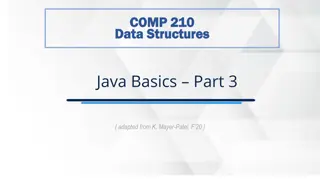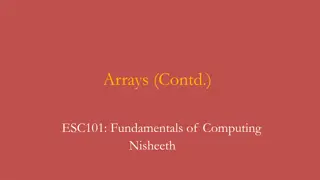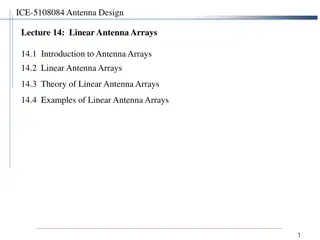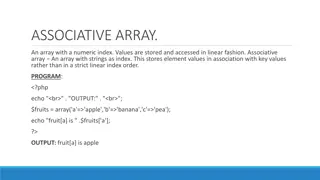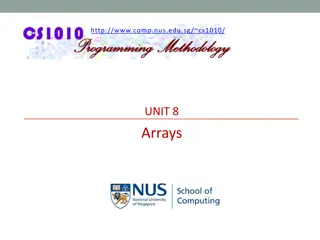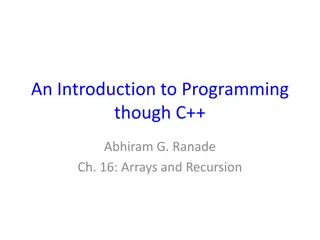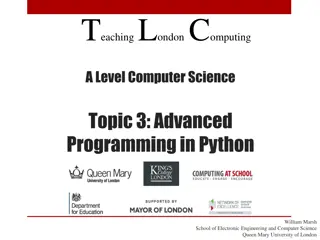
Understanding Arrays in Java Programming
Learn about arrays in Java programming, including creation, initialization, looping, and operations. See examples of array manipulation and common mistakes to avoid. Explore how to work with fixed-length data structures for storing multiple values of the same type efficiently.
Download Presentation

Please find below an Image/Link to download the presentation.
The content on the website is provided AS IS for your information and personal use only. It may not be sold, licensed, or shared on other websites without obtaining consent from the author. If you encounter any issues during the download, it is possible that the publisher has removed the file from their server.
You are allowed to download the files provided on this website for personal or commercial use, subject to the condition that they are used lawfully. All files are the property of their respective owners.
The content on the website is provided AS IS for your information and personal use only. It may not be sold, licensed, or shared on other websites without obtaining consent from the author.
E N D
Presentation Transcript
Array: A fixed-length data structure for storing multiple values of the same type Example from last week: An array of odd numbers: 1 3 4 5 6 7 Indices (start from 0) 0 2 odds: 1 3 5 7 9 11 13 15 odds.length == 8 The type of all elements is int The value of the element at index 4 is 9: odds[4] == 9 2
Array Variables An array is denoted by the [] notation Examples: int[] odds; String[] names; int[][] matrix; // an array of arrays matrix: 3
Array Creation and Initialization What is the output of the following code: int[] odds = new int[8]; for (int i = 0; i < odds.length; i++) { System.out.print(odds[i] + " "); odds[i] = 2 * i + 1; System.out.print(odds[i] + " "); } Array creation: all elements get the default value for their type (0 for int) Output: 0 1 0 3 0 5 0 7 0 9 0 11 0 13 0 15 4
Array Creation and Initialization Creating and initializing small arrays with a-priori known values: int[] odds = {1,3,5,7,9,11,13,15}; String[] months = {"Jan", "Feb", "Mar", "Apr", "May", "Jun", "July", "Aug", "Sep", "Oct", "Nov", "Dec"}; months: Jan 5
Loop through Arrays By promoting the array's index: for (int i = 0; i < months.length; i++) { System.out.println(months[i]); } The variable month is assigned the next element in each iteration foreach: for (String month: months) { System.out.println(month); } 6
Operations on arrays The class Arrays provide operations on array Copy Sort Search Fill ... java.util.Arrays http://docs.oracle.com/javase/6/docs/api/index.html?java/util/Arr ays.html 7
Copying Arrays Assume: int[] array1 = {1,2,3}; int[] array2 = {8,7,6,5}; Na ve copy: array1 = array2; 8,7,6,5 1,2,3 array2 array1 What s wrong with this solution? 8
Copying Arrays Arrays.copyOf 1st argument: the original array 2nd argument: the length of the copy int[] arr1 = {1, 2, 3}; int[] arr2 = Arrays.copyOf(arr1, arr1.length); Arrays.copyOfRange 1st argument: the original array 2nd initial index of the range to be copied, inclusive 3rd argumrnt: final index of the range to be copied, exclusive 9
Question What is the output of the following code: int[] odds = {1, 3, 5, 7, 9, 11, 13, 15}; int newOdds[] = Arrays.copyOfRange(odds, 1, odds.length); for (int odd: newOdds) { System.out.print(odd + " "); } Output: 3 5 7 9 11 13 15 10
2D Arrays There are no 2D arrays in Java but you can build array of arrays: char[][] board = newchar[3][]; for (int i = 0; i < 3; i++) board[i] = new char[3]; Or equivalently: char[][] board = newchar[3][3]; 11 board
2D Arrays A more compact table: int[][] table = new int[10][]; for (int i = 0; i < 10; i++) { table[i] = new int[i + 1]; for (int j = 0; j <= i; j++) { table[i][j] = (i + 1) * (j + 1); } } 3 6 9 2 4 1 table 12
Fibonacci Fibonacci series 1, 1, 2, 3, 5, 8, 13, 21, 34 Definition: fib(0) = 1 fib(1) = 1 fib(n) = fib(n-1) + fib(n-2) en.wikipedia.org/wiki/Fibonacci_number
If-Else Statement public class Fibonacci { Assumption: n 0 /** Returns the n-th Fibonacci element */ public static int computeElement(int n) { if (n==0) return 1; else if (n==1) return 1; else return computeElement(n-1) + computeElement(n-2); } } Can be removed 14
Switch Statement public class Fibonacci { Assumption: n 0 /** Returns the n-th Fibonacci element */ public static int computeElement(int n) { switch(n) { case 0: return 1; case 1: return 1; default: return computeElement(n-1) + computeElement(n-2); } } } can be placed outside the switch 15
Switch Statement public class Fibonacci { Assumption: n 0 /** Returns the n-th Fibonacci element */ public static int computeElement(int n) { switch(n) { case 0: return 1; case 1: return 1; break; default: return computeElement(n-1) + computeElement(n-2); } } } Compilation Error: Unreachable Code 16
Iterative Fibonacci A loop instead of a recursion static int computeElement(int n) { if (n == 0 || n == 1) return 1; int prev = 1; int prevPrev = 1; int curr = 2; for (int i = 2 ; i < n ; i++) { curr = prev + prevPrev; prevPrev = prev; prev = curr; curr = prev + prevPrev; Assumption: n 0 Must be initialized. Why? } 2 3 5 3 1 2 2 1 1 } return curr; prevPrev prev curr 17
curr, prev - prevPrev " KISS ( " . : keep it simple stupid ) - 18
For Loop Printing the first n elements: public class Fibonacci { public static int computeElement(int n) { } It is better to use args[0] } public static void main(String[] args) { for(int i = 0 ; i < 10 ; i++) { System.out.println(computeElement(i)); } 19
for vs. while The following two statements are almost equivalent: for(int i = 0 ; i < n ; i++) System.out.println(computeElement(i)); Variable i is not defined outside the for block int i=0; while (i < n) { System.out.println(computeElement(i)); i++; } 22
while vs. do while The following two statements are equivalent if and only if n>0 : int i=0; while (i < n) { System.out.println(computeElement(i)); i++; } int i=0; do { } while (i>n(; System.out.println(computeElement(i)); i++; 23
Compilation vs. Runtime Errors " bytecode " " :) - ( Syntax error on token "Class", class expected : Class MyClass { void f() { int n=10; int i; System.out.println(i); void g() { int m = 20; } } Syntax error, insert "}" to complete MethodBody : , , 24 24
Compilation vs. Runtime Errors ( : ) a = new int[20]; : int a[] = new int[10]; a[15] = 10; String s = null; System.out.println(s.length()); exceptions ) , ( 25 25
Compilation vs. Runtime Errors , ? , public class Factorial { /** calculate x! **/ public static int factorial(int x) { int f = 0; for (int i = 2; i <= x; i++) f = f * i; return f; } } 26 26
The Debugger Some programs may compile correctly, yet not produce the desirable results These programs are valid and correct Java programs, yet not the programs we meant to write! The debugger can be used to follow the program step by step and may help detecting bugs in an already compiled program
Debugger Add Breakpoint Right click on the desired line Toggle Breakpoint
Debugger Start Debugging debug (F11) breakpoint
Debugger Debugging Current state Back to Java perspective Current location
Using the Debugger: Video Tutorial http://eclipsetutorial.sourceforge.net/debugger.html http://www.vogella.com/tutorials/EclipseDebugging/articl e.html 33

